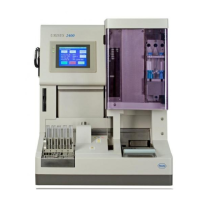Roche Diagnostics
C-6 Operator’s Manual · Version 1.0
5 Daily operation URISYS 2400
System start
a To enter the routine sequence number, STAT sequence number and
operator ID
1 Ensure the [Start Condition] screen is displayed.
2 Enter a starting routine sequence number (Routine Seq. No.) to start a
series of measurements with a number different from the displayed routine
sequence number. Four-digit numbers are accepted by the analyzer in the
indicated “Input Area” number range only.
3 Press <Enter>.
4 Enter a starting STAT sequence number (STAT Seq. No.) to give the next
STAT sample a number different from the displayed STAT sequence
number. Three-digit numbers are accepted by the analyzer in the indicated
“Input Area” number range only.
5 Press <Enter>.
6 Enter an operator ID between 1 and 99.
7 Press <Enter>.
8 Press <PgUp> to return to the [Routine Monitor] screen.
An example of the numbering
ranges would be as follows:
122 samples have been measured starting with Seq. No. 0001. The displayed
Routine Seq. No. is 0123. No samples with higher sequence numbers have
been measured. In this case, an input range of 0123-0996 is displayed.
For example, the next occupied (measured) sequence number is 0001. Due to
the ring buffer structure of the result memory, this is equivalent to 1001. The
end of the input range is calculated as 1001 - 5 = 996. Input of 996 allows the
measurement of one additional rack with 5 samples before reaching the next
occupied sequence number. For alarm messages when reaching the next
occupied sequence number, see:
The “Input Area” indicates the sequence number range that follows the displayed
sequence number and is not yet occupied by sample results. The range end number
is the number of the next occupied sequence number minus five.
“Start analysis of samples” on page C-10
When using the “Overwrite Mode”, be aware that the sequence number will swap to
1 automatically after the sequence counter has reached 1000 (or 200 for STAT). In
this case, the instrument starts to overwrite results with sequence numbers starting
at 1 again.
If the “Input Area” is indicated as 0000 - 0000, delete the results of samples
with sequence numbers higher than the displayed Seq. No., (see “Delete
routine or STAT sample data” on page C-27). Otherwise, analysis of samples
cannot continue.

